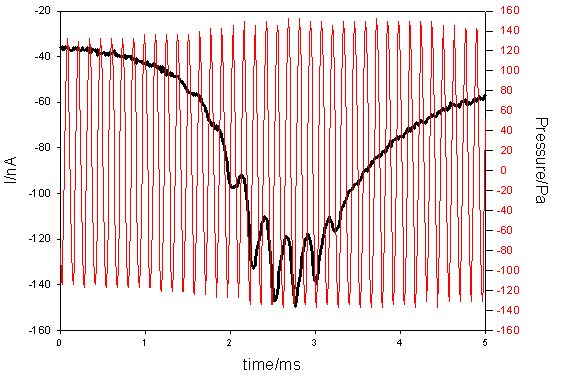  A single frame (above left) from a movie (above right) labels a hyperdermic needle (N) through which air bubbles are injected in to liquid (see below for details). A electrochemical sensor for mass flux comprises a 25-micron diameter platinum disc at the tip of a glass cone, seen at the top of the frame. This disc is the exposed part of a 25-micron diameter platinum wire (M), which runs along the central axis of an insulating glass rod (G), whose outer diameter (above the taper at the top of the frame) is 2 mm. |
 |
| The bubbles are continuously exposed to a 7.678 kHz sound field. This makes them undergo both a spherically symmetric pulsation (the 'breathing mode' oscillation, at 7.678 kHz, the frequency of the driving sound field) and also stimulates a Faraday wave on the bubble wall at half the frequency of the driving sound field (click here to learn more about Faraday waves). The graph on the right plots the simultaneous pressure (red) and electrochemical (black) time histories, as a bubble first approaches the electrode tip (which causes an increase in the magnitude of the electrochemical current) and then rises under buoyancy to move up and away from the cone tip (which causes a decrease in the magnitude of the electrochemical current). Whilst the visual image (the video) is dominated the bubble's translational motion, it is the Faraday wave which dominates the oscillation in the electrochemical signal, as proven by the fact that the latter is at half the frequency of the driving field. | |
Click here for more on Acoustoelectrochemistry.
(Video: PR Birkin, YE Watson, TG Leighton).